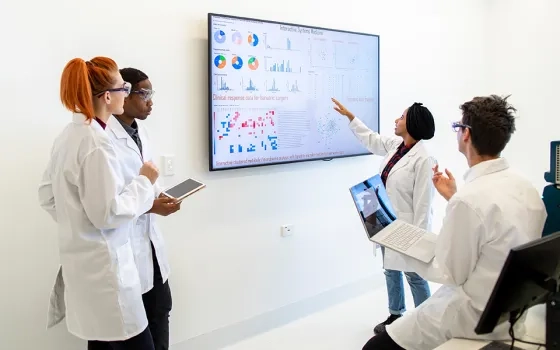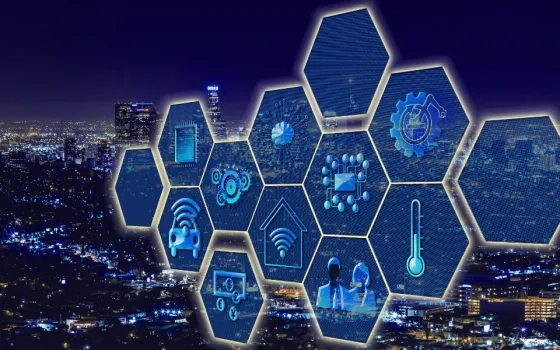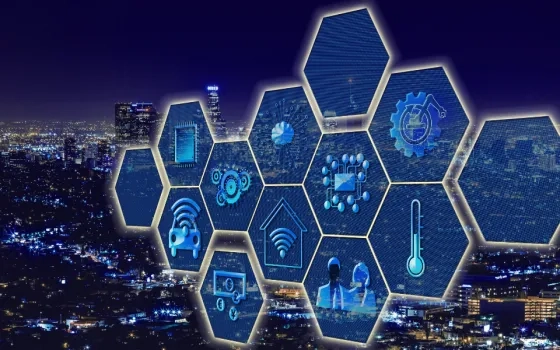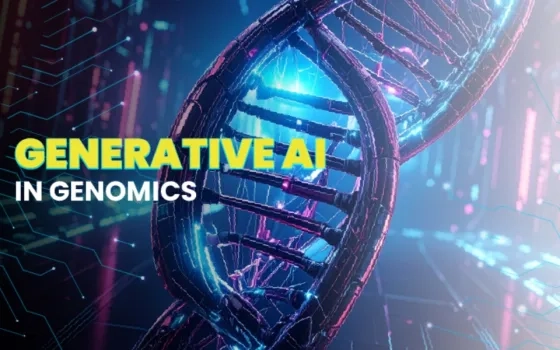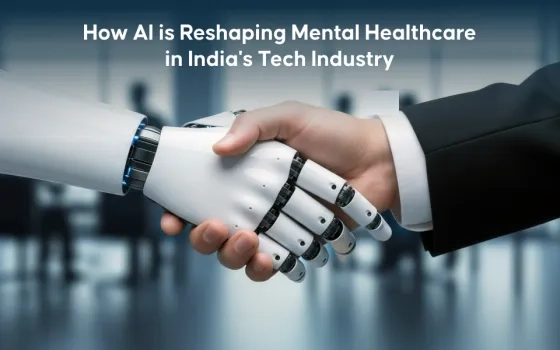AI has aided in tackling the recent pandemic
There is a strong belief that proven study plans utilizing AI would be of great benefit in assisting people in combating infections.
Few know that Coronavirus and its allied disease Covid-19 was first discovered by a data-mining program. HealthMap, a website run by Boston Children’s Hospital, raised an alarm about multiple cases of pneumonia in Wuhan, China, rating its urgency at three on a scale of five.
Soon after this discovery, the pandemic hit the world like a tsunami. As it progressed, governments struggled to deal with the unprecedented crisis on multiple fronts and were forced to look at innovative ways to augment their efforts, presenting an opportunity to leverage AI.
AI was used in varied settings including drug discovery, testing, prevention and overcoming resource constraints, and its success opened a whole new door of possibilities.
Here’s a look at some of the most intuitive, innovative and advantageous uses of the technology during COVID-19, outlined under the four categories of diagnosis and prognosis, prediction and tracking, patient care and drug development:
Diagnosis and prognosis of COVID-19 using AI
Diagnosis of COVID -19 pneumonia: Rapid diagnosis and identification of high-risk patients was challenging during peak COVID-19. Using a large, computed tomography (CT) database from 3,777 patients, researchers developed an AI system that could diagnose novel coronavirus pneumonia (NCP) and differentiate it from common pneumonia.
The AI system was able to provide accurate clinical prognosis, assisting clinicians with early clinical management and appropriate allocation of resources.
Prognosis using AI on X-ray images: The AI system was trained for automatic prediction of deterioration risk 9 using a deep neural network that learned from chest X-ray images and routine clinical variables, using data from 3,661 patients.
The deep neural network extracted informative areas of chest X-ray images to assist clinicians and performed comparably to two radiologists in a reader study.
Detecting COVID-19 based on the sound of cough: The MIT team developed a program using audio input from tens of thousands of patients coughing and self-reported clinical information to detect differences in the way a symptomatic COVID-19 patient coughs compared to a non-infected patient even though doctors cannot differentiate between them.
Predicting clinical outcomes in COVID-19 patients: Federated learning is a method used for training artificial intelligence models with data from multiple sources, while maintaining anonymity, thus removing many barriers to data sharing.
Researchers used data from 20 institutes across the globe to train a model, called Electronic Medical Record (EMR) Chest X-Ray AI Model ( EXAM 11 ) that predicts the future oxygen requirements of symptomatic patients using inputs of vital signs, laboratory data and chest X-rays.
Identifying at -risk patients: Medical Home Network, a Chicago-based non-profit, created a health risk screening platform 12 to identify Medicaid patients most at risk from COVID-19.
The platform used data on respiratory complications, social determinants of health and additional clinical parameters to predict the risk to patients. The program was successful in helping people in social isolation.
AI assistance in prediction and tracking
Susceptible, Infectious, and Recovered (SIR): SIR models categorize the infected population according to their individual infection or symptom status. While traditional SIR models used a limited set of data elements, the advances in deep learning allowed researchers to use all available data to model, analyze and forecast the virus’s spread or containment.
Accurately modeling the spread of an infection is key to help governments take containment measures.
The Global Epidemic and Mobility (GLEaM 4 ) model: The GLEaM model combines real-world data on human mobility with elaborate stochastic models of disease transmission. It provides analytic and forecasting power to address the challenges faced in developing intervention strategies that minimize the impact of potentially devastating epidemics.
It also allows teams to study the efficacy and outcomes of diverse intervention strategies, analyze threats through model scenarios, and forecast newly evolving infectious diseases.
Transportation Analysis and Simulation (TRANSIMS) system: TRANSIMS 5 uses unconventional computational techniques to predict the spread of COVID-19.
It can simulate the travel behavior of each individual for an entire 24-hour period based on the survey data received, which includes statistics on the volume of traffic and congestion, time-dependent delays for the entire road and transit network, and queues at intersections.
Tracker map to predict COVID-19 hotspots: Cotiviti, a healthcare AI company, developed a COVID-19 tracker map that could accurately predict new COVID-19 outbreaks in the United States.
The tracker map uses big data models and AI technologies to show the relative risk of infection for people with underlying health conditions in affected areas. This was a helpful tool 7 for public health officials to direct their limited resources to those most in need.
AI-backed, superior care for COVID-19
Smart field hospitals: Following the outbreak, a Smart field hospital was built in the Hongshan Sports Center in Wuhan, China. It was staffed with robots responsible for administering medications, taking vitals, and disinfecting the facility.
In addition to helping the hospital staff, specialized robots were used to provide entertainment and information to the 200,000 people at the hospital.
Thermal sensing drones: South Korea used drones to completely disinfect high epidemic areas. In Xinchang County, China, the drones delivered medical supplies to centers in need, and thermal sensing drones identified people running fever, potentially infected with the virus.
Chatbots as assistants: Several public and private care providers leveraged chatbots to help patients and medical workers. Chatbots were able to respond to a flood of enquiries about symptoms in various languages with a human-touch, enabling people to receive timely, accurate information.
The United States’ Center for Disease Control and Prevention and Microsoft developed a coronavirus self-checker service to help users self-assess their condition and suggest a course of action.
Combating misinformation on social media platforms: Social networks were full of misinformation about the pandemic, which led to the general public challenging restrictions, often gathering in large numbers to protest the measures.
To counter this, social networks and search engines used personalized information and AI algorithms to identify problematic material on their platforms and have it removed.
Drug development with AI
There are several mechanisms, where AI accelerated the research on COVID-19. The key thing to note is much of the cutting-edge research is open source and thus available to the scientific and medical research community for further development or consumption.
Computational predictions of protein structures associated with COVID-19: Knowledge of a protein’s structure is essential to gain understanding of how it functions. AlphaFold by Google’s DeepMind is a deep learning system, that predicts protein structure accurately, even when no structures of similar proteins are available.
This is referred to as “free modelling”. AlphaFold’s prediction matched the spike protein structure experimentally determined for SARS-CoV-2 in the Protein Data Bank.
Predictions for quicker vaccine development: Messenger RNA (mRNA) has a secondary structure that instructs cells to make proteins. Understanding the instruction and protein translation was key to the development of mRNA vaccine.
However, mRNAs have a short half-life and degrade rapidly. This impacts the structural analysis of the virus. Access to quick viral structural analysis was significant to shorten the time it takes to design a potential mRNA vaccine with higher stability and better effectiveness, providing an opportunity to save thousands of lives.
Baidu AI team deployed Linearfold, a model to predict the secondary structure prediction for the COVID-19 RNA sequence, reducing overall analysis time from 55 minutes to 27 seconds. Baidu also released the model for public use.
Identifying existing medicines to repurpose for COVID-19 treatment: MIT scientists conducted research to identify existing drugs that could be repurposed to treat COVID-19.
Their hypothesis was that since older people tend to be at higher risk of severe disease and death, the virus would trigger gene expression differently in them, compared to younger patients. This information was useful to determine which drugs affect specific genes and proteins triggered by the infection.
The future of AI in health care
An AI solution must undergo a wide range of conditions and edge scenarios before it is deemed fit for use in terms of fairness, reliability, accountability, privacy, transparency, and safety.
It also requires continuous monitoring of output vis-à-vis the everchanging real world, so it can learn from it.
Finally, policy formulation must support adoption of technology but tread with caution. FDA is actively working with stakeholders to define a comprehensive lifecycle-based framework that addresses the use of these technologies in medical care.
This evolving framework differs significantly from FDA’s own traditional regulatory control paradigm. Artificial Intelligence has proved its value during the pandemic and holds much promise for mitigating future health care crises.
However, this is just a start and the possibilities for intelligent care are limitless. This makes AI in health care an area of great opportunity for talented technologists who are also passionate about making an impact on people and communities through their work.
Based on lessons learnt from the use of AI during the pandemic, policy makers, research institutes, businesses and technologists must incorporate these learnings as they chart the way forward.
The article is written by Anupam Gupta, Vice President Data Science, Optum Global Solutions (India) and has been published in Times of India.



